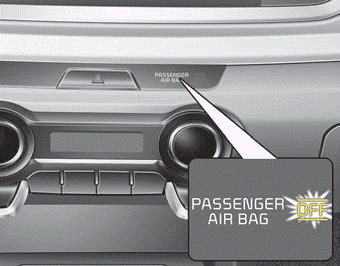Kia Rio: Air bag - advanced supplemental restraint system / Occupant detection system

Your vehicle is equipped with an occupant detection system in the front passenger's seat.
The occupant detection system is designed to detect the presence of a properly-seated front passenger and determine if the passenger's front air bag should be enabled (may inflate) or not. Only the front passenger front air bag is controlled by the Occupant Detection System.
Do not put anything in front of the passenger air bag
 indicator.
indicator.
Main components of occupant detection system
- A detection device located within the front passenger seat cushion.
- An electronic system which determines whether the passenger air bag systems should be activated or deactivated.
- An indicator light located on the instrument panel which illuminates the words PASSENGER AIR BAG “OFF” indicating the front passenger air bag system is deactivated.
- The instrument panel air bag warning light is interconnected with the occupant detection system.
If the front passenger seat is occupied by a person that the system determines to be of adult size, and he/she sits properly (sitting upright with the seatback in an upright position, centered on the seat cushion with their seat belt on, legs comfortably extended and their feet on the floor), the PASSENGER AIR BAG “OFF” indicator will turn off and the front passenger's air bag will be able to inflate, if necessary, in frontal crashes.
You will find the PASSENGER AIR BAG “OFF” indicator on the center facia panel. This system detects the conditions 1~4 in the following table and activates or deactivates the front passenger air bag based on these conditions.
Always be sure that you and all vehicle occupants are seated and restrained properly (sitting upright with the seat in an upright position, centered on the seat cushion, with the person’s legs comfortably extended, feet on the floor, and wearing the safety belt properly) for the most effective protection by the air bag and the safety belt.
• The ODS (Occupant Detection System) may not function properly if the passenger takes actions which can defeat the detection system. These include:
(1) Failing to sit in an upright position.
(2) Leaning against the door or center console.
(3) Sitting towards the sides or the front of the seat.
(4) Putting legs on the dashboard or resting them on other locations which reduce
the passenger weight on the front seat.
(5) Improperly wearing the safety belt.
(6) Reclining the seat back.
 SRS components and functions
SRS components and functions
The SRS consists of the following components:
1. Driver's front air bag module
2. Passenger's front air bag module
3. Side air bag modules
4. Curtain air bag modules
5. Retractor pre-tensioner ...
 Condition and operation in the front passenger occupant detection system
Condition and operation in the front passenger occupant detection system
*1) The system judges a person of adult size as an adult. When a smaller adult
sits in the front passenger seat, the system may recognize him/her as a child depending
on his/her physique and pos ...
Other information:
Kia Rio 2017-2025 YB Owners Manual: Good driving practices
Never move the shift lever from P (Park) or N (Neutral) to any other position with the accelerator pedal depressed. Never move the shift lever into P (Park) when the vehicle is in motion. Be sure the vehicle is completely stopped before you attempt to shift into R (Reverse) or D (Drive) ...
Kia Rio 2017-2025 YB Owners Manual: Headlamp (Low/High beam) (LED type) bulb replacement (Headlamp Type B), Front turn signal lamp bulb replacement (Headlamp Type B)
Headlamp (Low/High beam) (LED type) bulb replacement (Headlamp Type B) If the headlamp (Low/High beam) (1) does not operate, have the vehicle checked by an authorized Kia dealer. Front turn signal lamp bulb replacement (Headlamp Type B) 1. Open the hood. 2. Remove the headlamp bulb cover b ...
